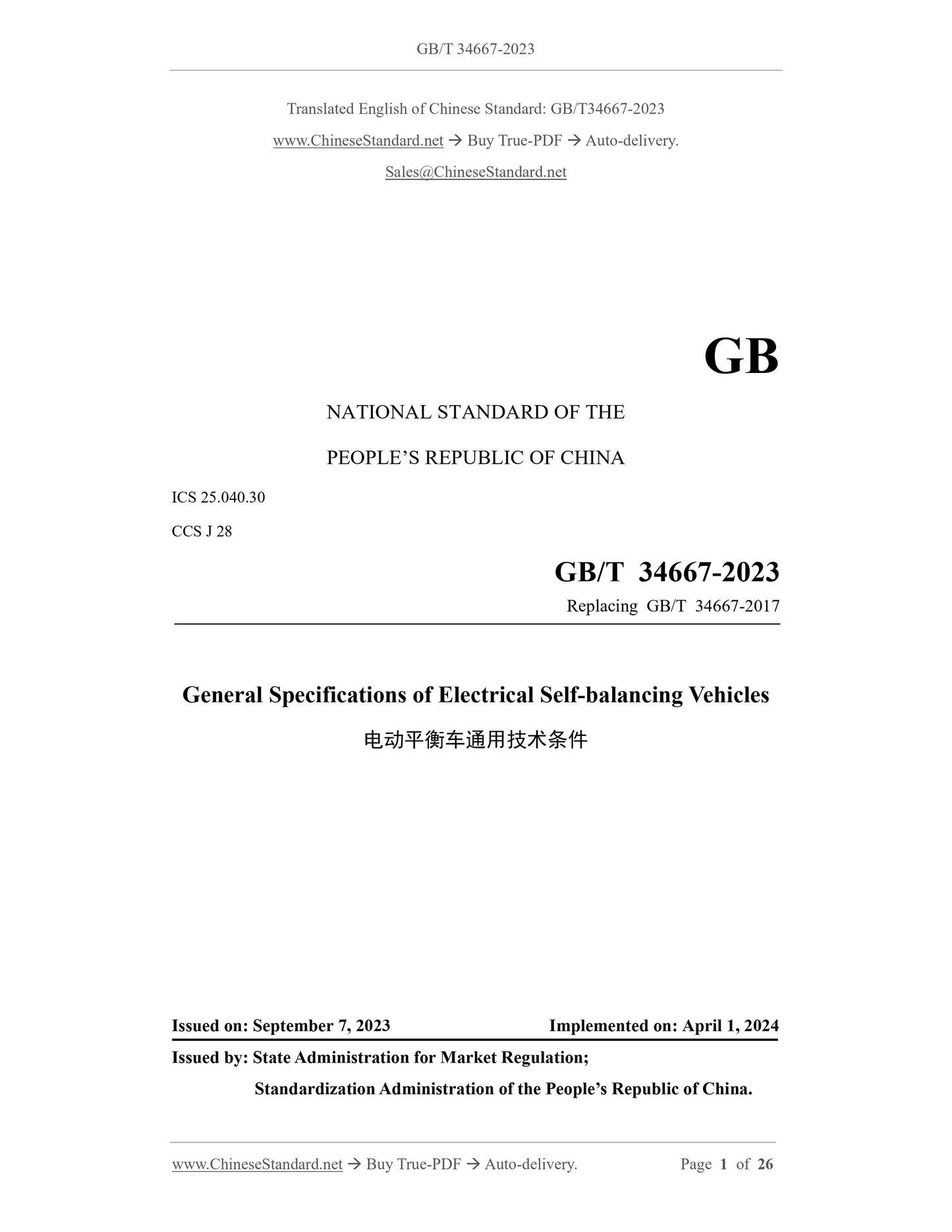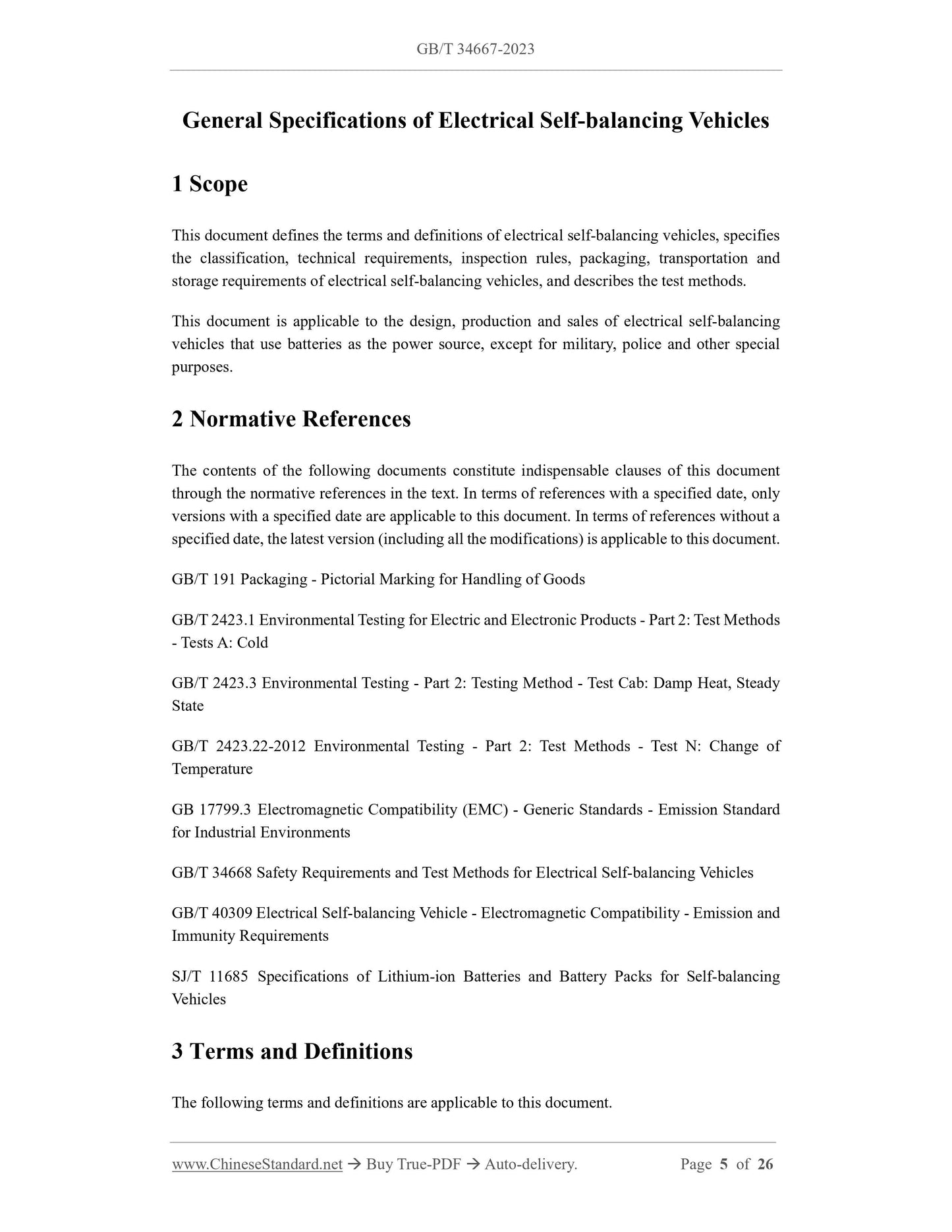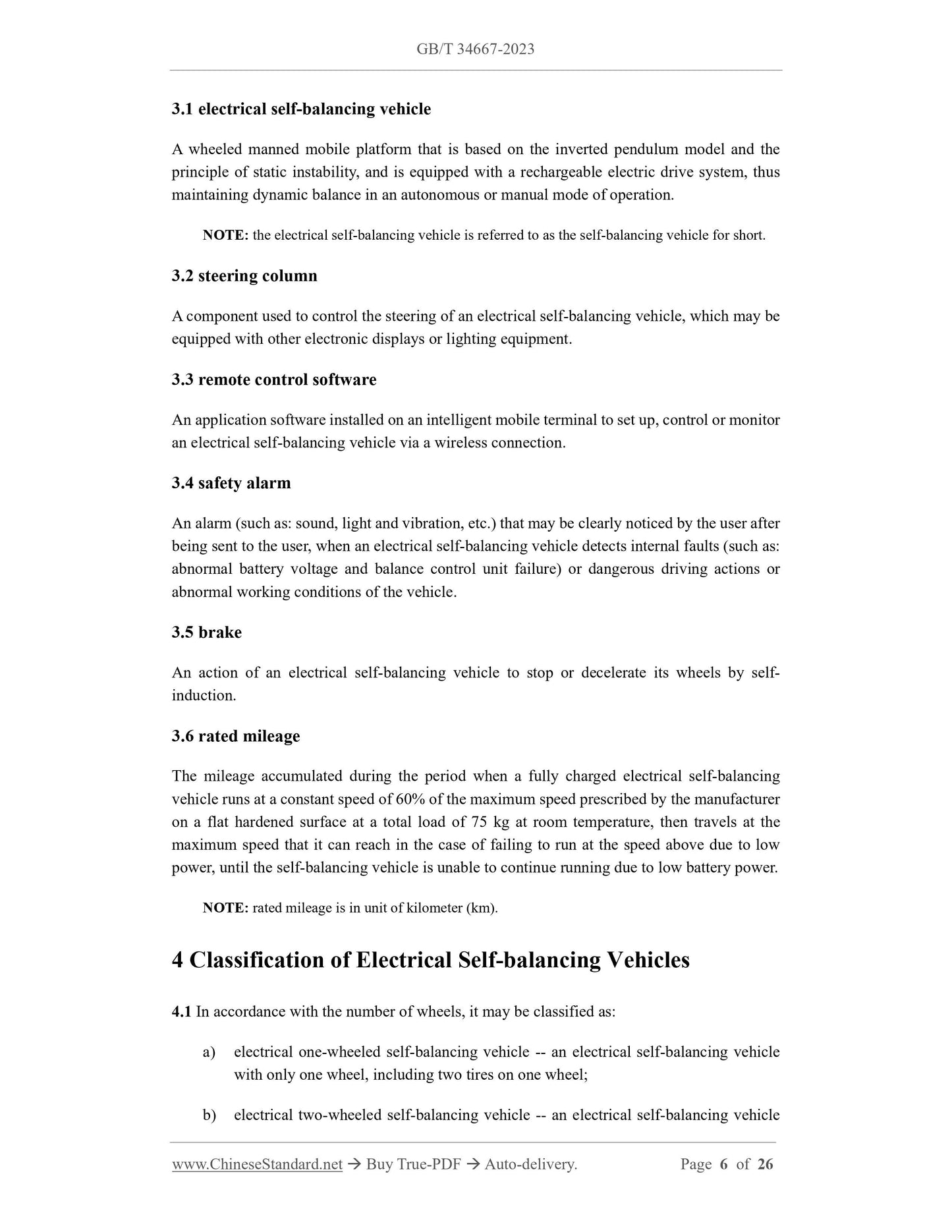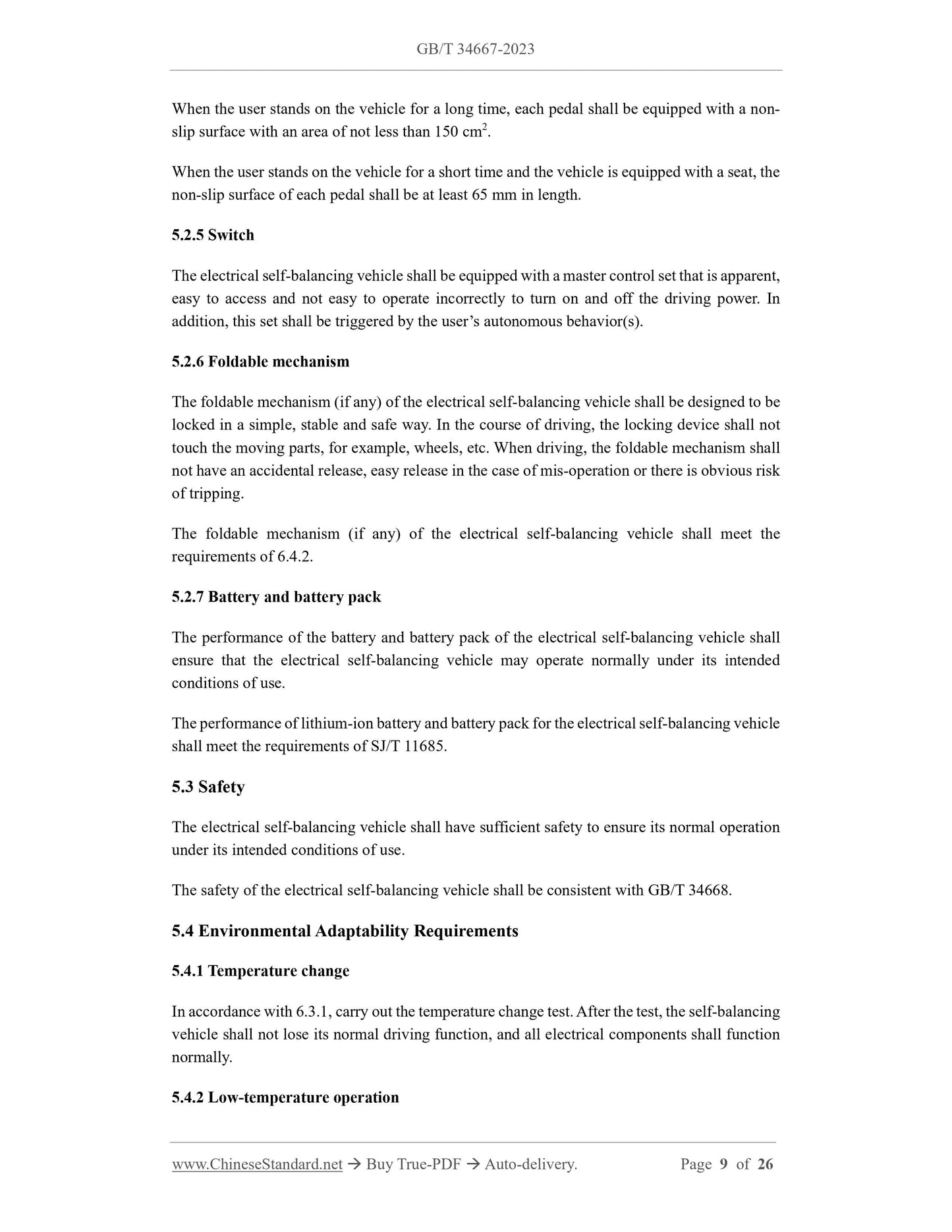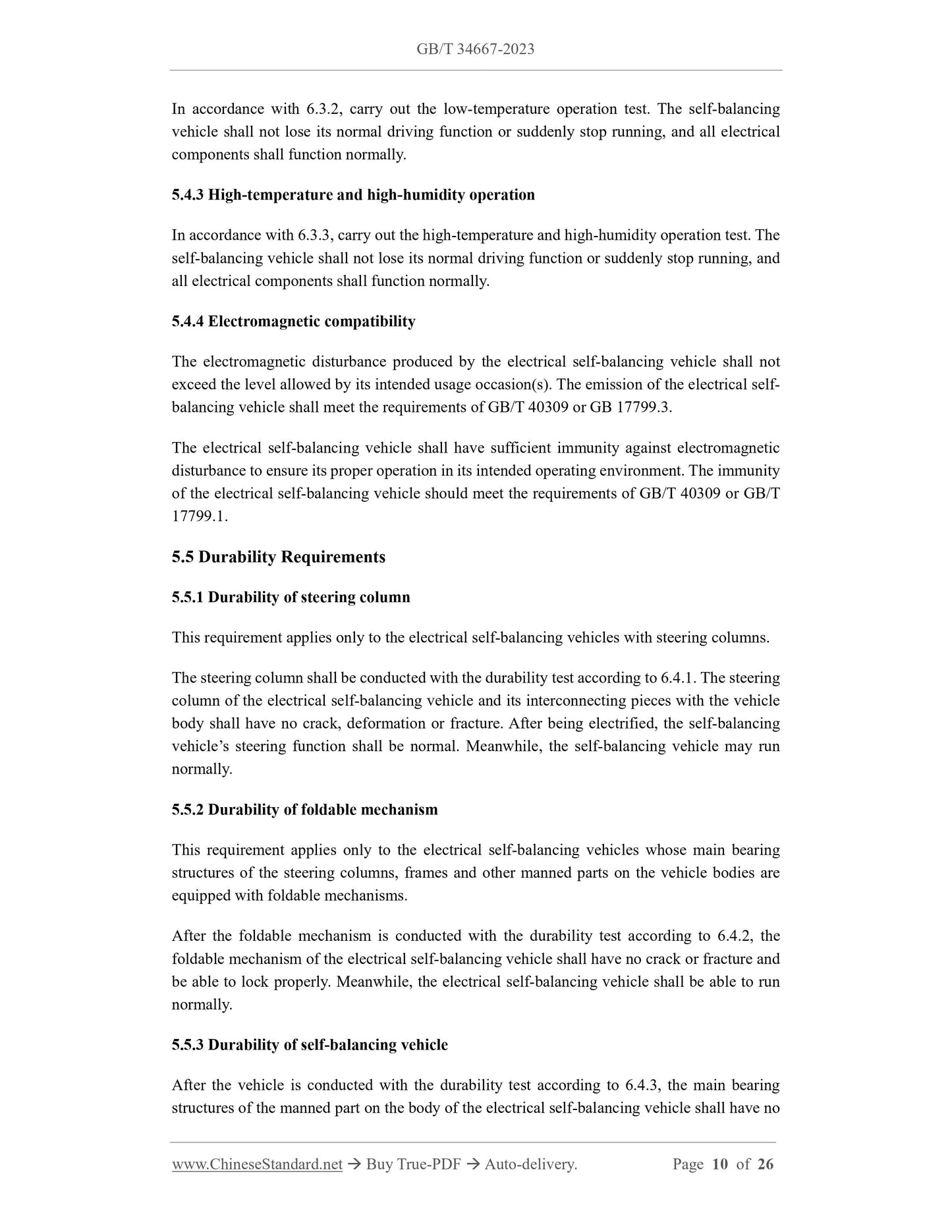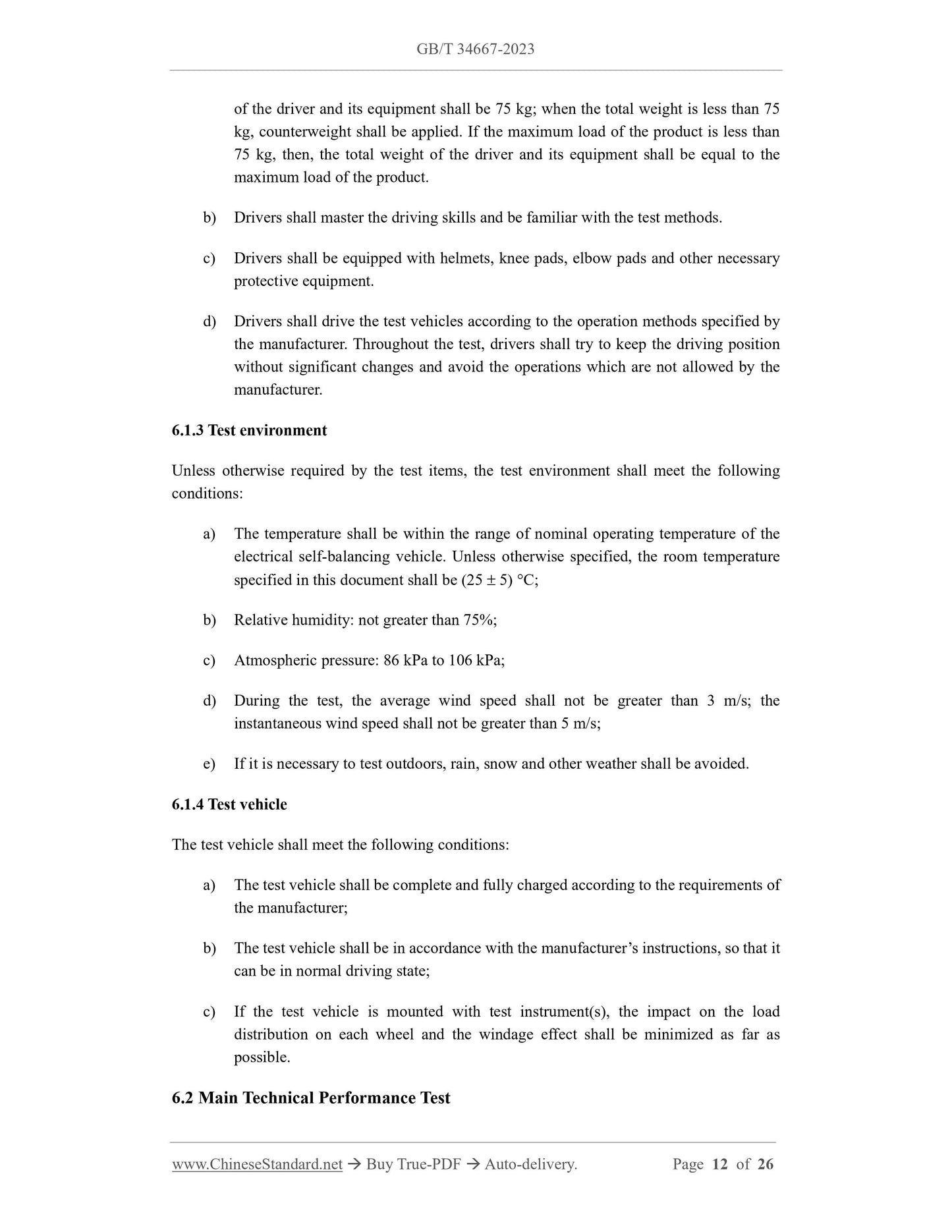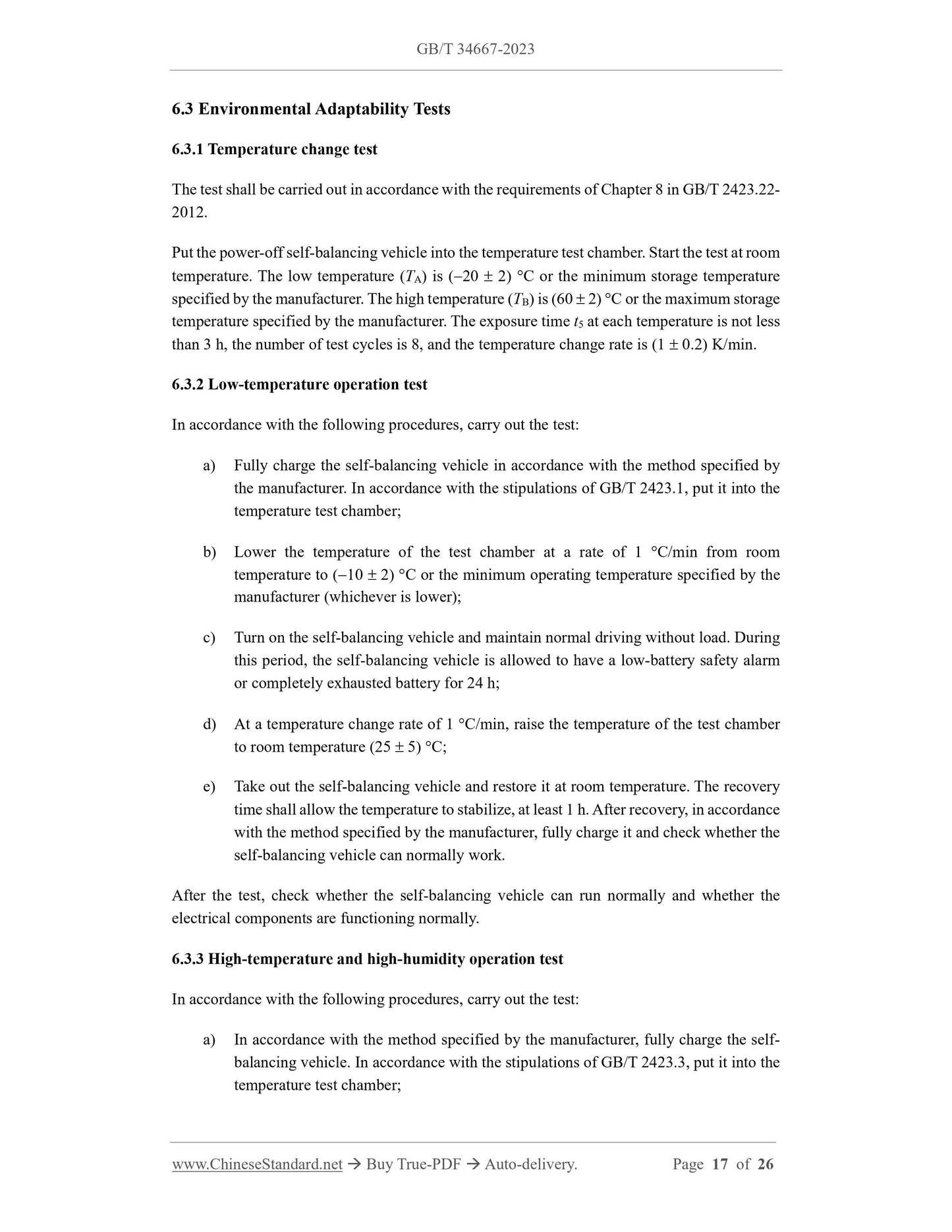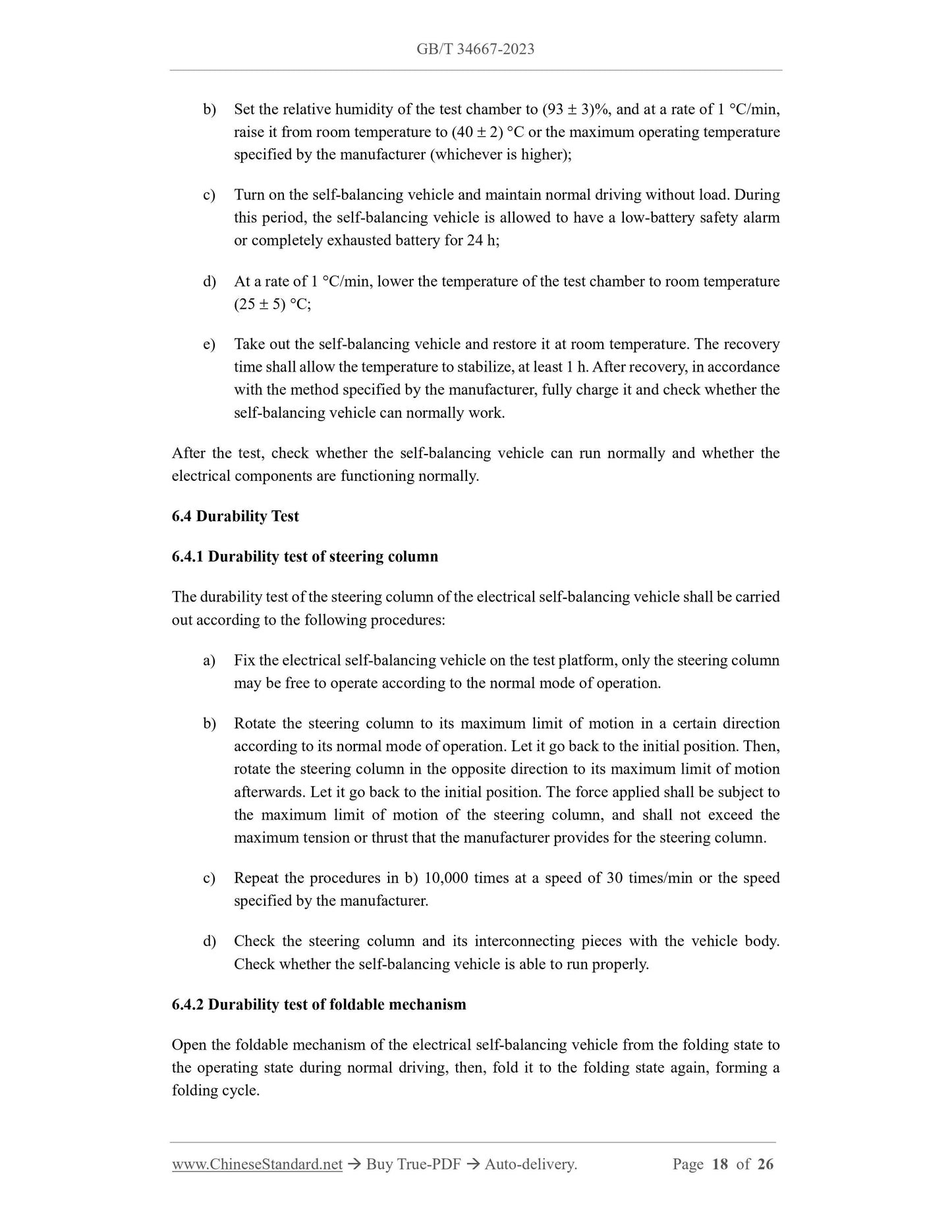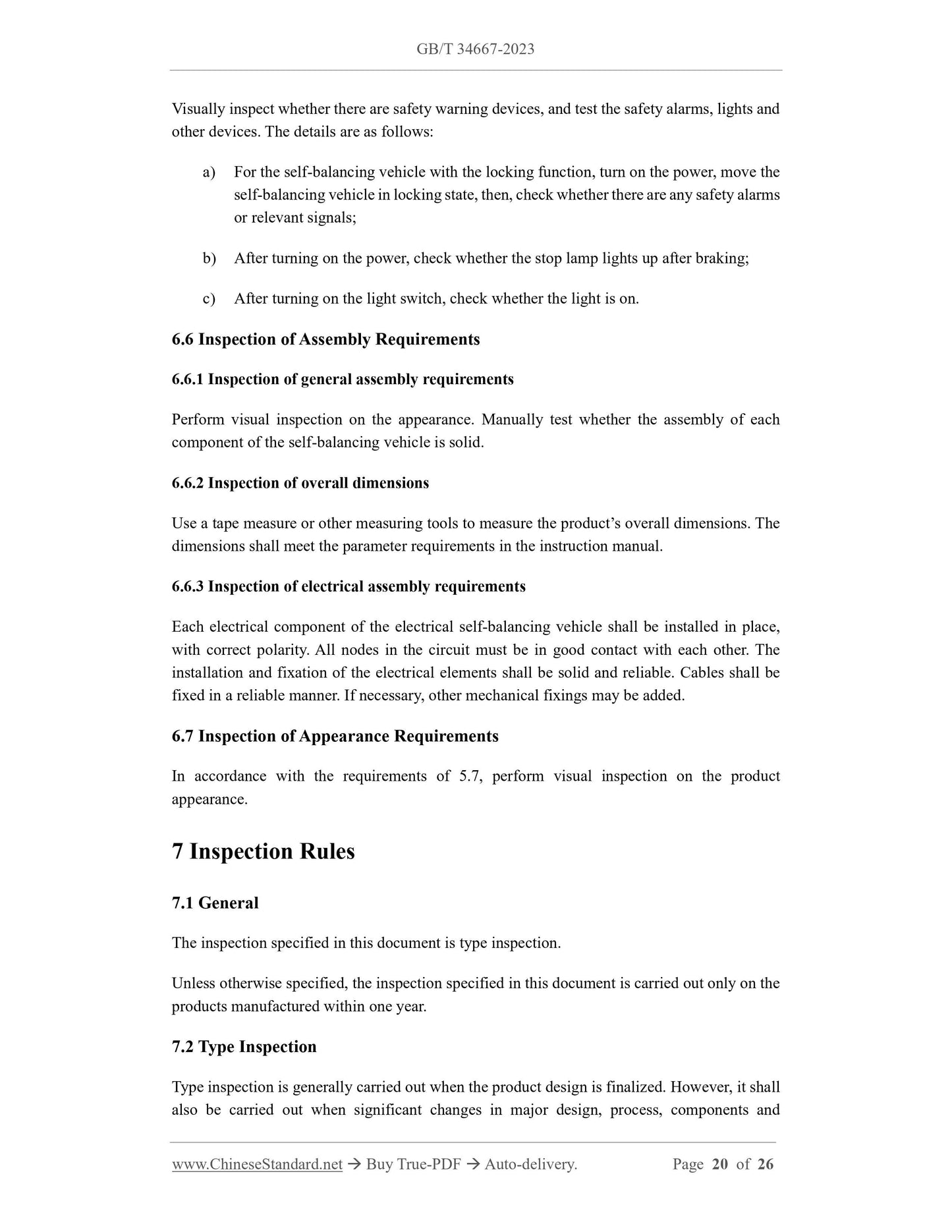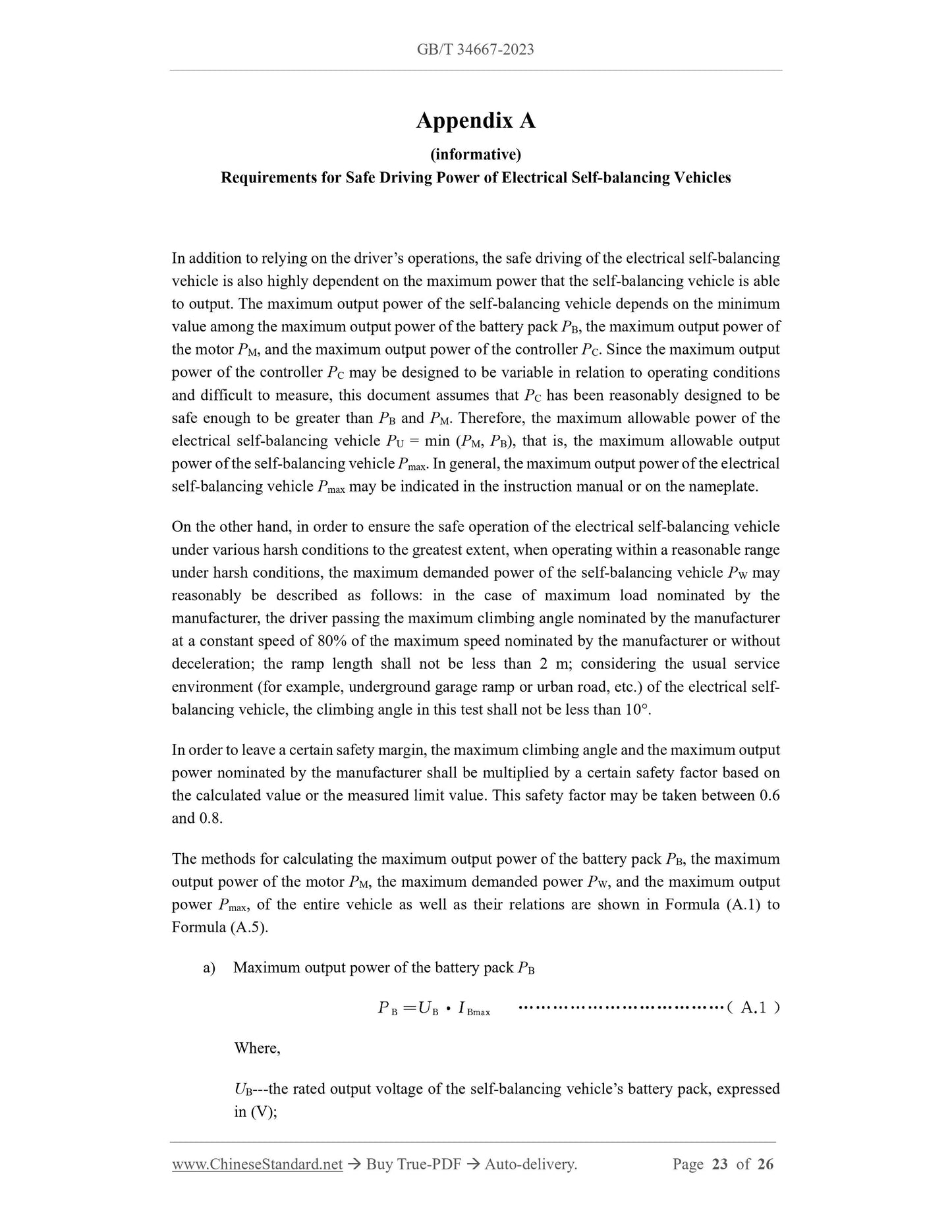1
/
of
12
www.ChineseStandard.us -- Field Test Asia Pte. Ltd.
GB/T 34667-2023 English PDF (GB/T34667-2023)
GB/T 34667-2023 English PDF (GB/T34667-2023)
Regular price
$325.00
Regular price
Sale price
$325.00
Unit price
/
per
Shipping calculated at checkout.
Couldn't load pickup availability
GB/T 34667-2023: General specifications of electrical self-balancing vehicles
Delivery: 9 seconds. Download (& Email) true-PDF + Invoice.
Get Quotation: Click GB/T 34667-2023 (Self-service in 1-minute)
Historical versions (Master-website): GB/T 34667-2023
Preview True-PDF (Reload/Scroll-down if blank)
GB/T 34667-2023
GB
NATIONAL STANDARD OF THE
PEOPLE’S REPUBLIC OF CHINA
ICS 25.040.30
CCS J 28
Replacing GB/T 34667-2017
General Specifications of Electrical Self-balancing Vehicles
ISSUED ON: SEPTEMBER 7, 2023
IMPLEMENTED ON: APRIL 1, 2024
Issued by: State Administration for Market Regulation;
Standardization Administration of the People’s Republic of China.
Table of Contents
Foreword ... 3
1 Scope ... 5
2 Normative References ... 5
3 Terms and Definitions ... 5
4 Classification of Electrical Self-balancing Vehicles ... 6
5 Technical Requirements ... 7
6 Test Methods ... 11
7 Inspection Rules ... 20
8 Packaging, Transportation and Storage ... 21
Appendix A (informative) Requirements for Safe Driving Power of Electrical Self-
balancing Vehicles ... 23
Bibliography ... 26
General Specifications of Electrical Self-balancing Vehicles
1 Scope
This document defines the terms and definitions of electrical self-balancing vehicles, specifies
the classification, technical requirements, inspection rules, packaging, transportation and
storage requirements of electrical self-balancing vehicles, and describes the test methods.
This document is applicable to the design, production and sales of electrical self-balancing
vehicles that use batteries as the power source, except for military, police and other special
purposes.
2 Normative References
The contents of the following documents constitute indispensable clauses of this document
through the normative references in the text. In terms of references with a specified date, only
versions with a specified date are applicable to this document. In terms of references without a
specified date, the latest version (including all the modifications) is applicable to this document.
GB/T 191 Packaging - Pictorial Marking for Handling of Goods
GB/T 2423.1 Environmental Testing for Electric and Electronic Products - Part 2: Test Methods
- Tests A: Cold
GB/T 2423.3 Environmental Testing - Part 2: Testing Method - Test Cab: Damp Heat, Steady
State
GB/T 2423.22-2012 Environmental Testing - Part 2: Test Methods - Test N: Change of
Temperature
GB 17799.3 Electromagnetic Compatibility (EMC) - Generic Standards - Emission Standard
for Industrial Environments
GB/T 34668 Safety Requirements and Test Methods for Electrical Self-balancing Vehicles
GB/T 40309 Electrical Self-balancing Vehicle - Electromagnetic Compatibility - Emission and
Immunity Requirements
SJ/T 11685 Specifications of Lithium-ion Batteries and Battery Packs for Self-balancing
Vehicles
3 Terms and Definitions
The following terms and definitions are applicable to this document.
3.1 electrical self-balancing vehicle
A wheeled manned mobile platform that is based on the inverted pendulum model and the
principle of static instability, and is equipped with a rechargeable electric drive system, thus
maintaining dynamic balance in an autonomous or manual mode of operation.
NOTE: the electrical self-balancing vehicle is referred to as the self-balancing vehicle for short.
3.2 steering column
A component used to control the steering of an electrical self-balancing vehicle, which may be
equipped with other electronic displays or lighting equipment.
3.3 remote control software
An application software installed on an intelligent mobile terminal to set up, control or monitor
an electrical self-balancing vehicle via a wireless connection.
3.4 safety alarm
An alarm (such as: sound, light and vibration, etc.) that may be clearly noticed by the user after
being sent to the user, when an electrical self-balancing vehicle detects internal faults (such as:
abnormal battery voltage and balance control unit failure) or dangerous driving actions or
abnormal working conditions of the vehicle.
3.5 brake
An action of an electrical self-balancing vehicle to stop or decelerate its wheels by self-
induction.
3.6 rated mileage
The mileage accumulated during the period when a fully charged electrical self-balancing
vehicle runs at a constant speed of 60% of the maximum speed prescribed by the manufacturer
on a flat hardened surface at a total load of 75 kg at room temperature, then travels at the
maximum speed that it can reach in the case of failing to run at the speed above due to low
power, until the self-balancing vehicle is unable to continue running due to low battery power.
NOTE: rated mileage is in unit of kilometer (km).
4 Classification of Electrical Self-balancing Vehicles
4.1 In accordance with the number of wheels, it may be classified as:
a) electrical one-wheeled self-balancing vehicle -- an electrical self-balancing vehicle
with only one wheel, including two tires on one wheel;
b) electrical two-wheeled self-balancing vehicle -- an electrical self-balancing vehicle
with two wheels;
c) electrical multi-wheeled self-balancing vehicle -- an electrical self-balancing vehicle
with three or more wheels.
4.2 In accordance with the steering mode, it may be classified as:
a) electrical self-balancing vehicle with a steering column;
b) electrical self-balancing vehicle with no steering column.
4.3 In accordance with whether the seat is equipped, it may be classified as:
a) electrical self-balancing vehicle with a seat;
b) electrical self-balancing vehicle with no seat.
4.4 In accordance with the charging mode, it may be classified as:
a) rechargeable electrical self-balancing vehicle with external power supply -- this type
of electrical self-balancing vehicle is not directly connected to the AC grid during
charging, but connected to AC grid via a charger or external power supply for
charging;
b) rechargeable electrical self-balancing vehicle with built-in power supply -- this type
of electrical self-balancing vehicle is directly connected to the AC grid during
charging.
5 Technical Requirements
5.1 Main Technical Performance Requirements
5.1.1 General
The design of the main technical performance of the self-balancing vehicle shall firstly satisfy
the requirements for safe driving.
In terms of the tyres of the self-balancing vehicle, the minimum diameter is 125 mm and the
minimum width is 25 mm.
Refer to Appendix A for the analysis and evaluation of necessary conditions for the safe driving
of the self-balancing vehicle.
5.1.2 Maximum speed
In accordance with the maximum speed test in 6.2.1, the maximum speed shall not be greater
than 20 km/h.
When the user stands on the vehicle for a long time, each pedal shall be equipped with a non-
slip surface with an area of not less than 150 cm2.
When the user stands on the vehicle for a short time and the vehicle is equipped with a seat, the
non-slip surface of each pedal shall be at least 65 mm in length.
5.2.5 Switch
The electrical self-balancing vehicle shall be equipped with a master control set that is apparent,
easy to access and not easy to operate incorrectly to turn on and off the driving power. In
addition, this set shall be triggered by the user’s autonomous behavior(s).
5.2.6 Foldable mechanism
The foldable mechanism (if any) of the electrical self-balancing vehicle shall be designed to be
locked in a simple, stable and safe way. In the course of driving, the locking device shall not
touch the moving parts, for example, wheels, etc. When driving, the foldable mechanism shall
not have an accidental release, easy release in the case of mis-operation or there is obvious risk
of tripping.
The foldable mechanism (if any) of the electrical self-balancing vehicle shall meet the
requirements of 6.4.2.
5.2.7 Battery and battery pack
The performance of the battery and battery pack of the electrical self-balancing vehicle shall
ensure that the electrical self-balancing vehicle may operate normally under its intended
conditions of use.
The performance of lithium-ion battery and battery pack for the electrical self-balancing vehicle
shall meet the requirements of SJ/T 11685.
5.3 Safety
The electrical self-balancing vehicle shall have sufficient safety to ensure its normal operation
under its intended conditions of use.
The safety of the electrical self-balancing vehicle shall be consistent with GB/T 34668.
5.4 Environmental Adaptability Requirements
5.4.1 Temperature change
In accordance with 6.3.1, carry out the temperature change test. After the test, the self-balancing
vehicle shall not lose its normal driving function, and all electrical components shall function
normally.
5.4.2 Low-temperature operation
In accordance with 6.3.2, carry out the low-temperature operation test. The self-balancing
vehicle shall not lose its normal driving function or suddenly stop running, and all electrical
components shall function normally.
5.4.3 High-temperature and high-humidity operation
In accordance with 6.3.3, carry out the high-temperature and high-humidity operation test. The
self-balancing vehicle shall not lose its normal driving function or suddenly stop running, and
all electrical components shall function normally.
5.4.4 Electromagnetic compatibility
The electromagnetic disturbance produced by the electrical self-balancing vehicle shall not
exceed the level allowed by its intended usage occasion(s). The emission of the electrical self-
balancing vehicle shall meet the requirements of GB/T 40309 or GB 17799.3.
The electrical self-balancing vehicle shall have sufficient immunity against electromagnetic
disturbance to ensure its proper operation in its intended operating environment. The immunity
of the electrical self-balancing vehicle should meet the requirements of GB/T 40309 or GB/T
17799.1.
5.5 Durability Requirements
5.5.1 Durability of steering column
This requirement applies only to the electrical self-balancing vehicles with steering columns.
The steering column shall be conducted with the durability test according to 6.4.1. The steering
column of the electrical self-balancing vehicle and its interconnecting pieces with the vehicle
body shall have no crack, deformation or fracture. After being electrified, the self-balancing
vehicle’s steering function shall be normal. Meanwhile, the self-balancing vehicle may run
normally.
5.5.2 Durability of foldable mechanism
This requirement applies only to the electrical self-balancing vehicles whose main bearing
structures of the steering columns, frames and other manned parts on the vehicle bodies are
equipped with foldable mechanisms.
After the foldable mechanism is conducted with the durability test according to 6.4.2, the
foldable mechanism of the electrical self-balancing vehicle shall have no crack or fracture and
be able to lock properly. Meanwhile, the electrical self-balancing vehicle shall be able to run
normally.
5.5.3 Durability of self-balancing vehicle
After the vehicle is conducted with the durability test according to 6.4.3, the main bearing
structures of the manned part on the body of the electrical self-balancing vehicle shall have no
of the driver and its equipment shall be 75 kg; when the total weight is less than 75
kg, counterweight shall be applied. If the maximum load of the product is less than
75 kg, then, the total weight of the driver and its equipment shall be equal to the
maximum load of the product.
b) Drivers shall master the driving skills and be familiar with the test methods.
c) Drivers shall be equipped with helmets, knee pads, elbow pads and other necessary
protective equipment.
d) Drivers shall drive the test vehicles according to the operation methods specified by
the manufacturer. Throughout the test, drivers shall try to keep the driving position
without significant changes and avoid the operations which are not allowed by the
manufacturer.
6.1.3 Test environment
Unless otherwise required by the test items, the test environment shall meet the following
conditions:
a) The temperature shall be within the range of nominal operating temperature of the
electrical self-balancing vehicle. Unless otherwise specified, the room temperature
specified in this document shall be (25 5) °C;
b) Relative humidity: not greater than 75%;
c) Atmospheric pressure: 86 kPa to 106 kPa;
d) During the test, the average wind speed shall not be greater than 3 m/s; the
instantaneous wind speed shall not be greater than 5 m/s;
e) If it is necessary to test outdoors, rain, snow and other weather shall be avoided.
6.1.4 Test vehicle
The test vehicle shall meet the following conditions:
a) The test vehicle shall be complete and fully charged according to the requirements of
the manufacturer;
b) The test vehicle shall be in accordance with the manufacturer’s instructions, so that it
can be in normal driving state;
c) If the test vehicle is mounted with test instrument(s), the impact on the load
distribution on each wheel and the windage effect shall be minimized as far as
possible.
6.2 Main Technical Performance Test
6.3 Environmental Adaptability Tests
6.3.1 Temperature change test
The test shall be carried out in accordance with the requirements of Chapter 8 in GB/T 2423.22-
2012.
Put the power-off self-balancing vehicle into the temperature test chamber. Start the test at room
temperature. The low temperature (TA) is (20 2) C or the minimum storage temperature
specified by the manufacturer. The high temperature (TB) is (60 2) C or the maximum storage
temperature specified by the manufacturer. The exposure time t5 at each temperature is not less
than 3 h, the number of test cycles is 8, and the temperature change rate is (1 0.2) K/min.
6.3.2 Low-temperature operation test
In accordance with the following procedures, carry out the test:
a) Fully charge the self-balancing vehicle in accordance with the method specified by
the manufacturer. In accordance with the stipulations of GB/T 2423.1, put it into the
temperature test chamber;
b) Lower the temperature of the test chamber at a rate of 1 C/min from room
temperature to (10 2) C or the minimum operating temperature specified by the
manufacturer (whichever is lower);
c) Turn o...
Delivery: 9 seconds. Download (& Email) true-PDF + Invoice.
Get Quotation: Click GB/T 34667-2023 (Self-service in 1-minute)
Historical versions (Master-website): GB/T 34667-2023
Preview True-PDF (Reload/Scroll-down if blank)
GB/T 34667-2023
GB
NATIONAL STANDARD OF THE
PEOPLE’S REPUBLIC OF CHINA
ICS 25.040.30
CCS J 28
Replacing GB/T 34667-2017
General Specifications of Electrical Self-balancing Vehicles
ISSUED ON: SEPTEMBER 7, 2023
IMPLEMENTED ON: APRIL 1, 2024
Issued by: State Administration for Market Regulation;
Standardization Administration of the People’s Republic of China.
Table of Contents
Foreword ... 3
1 Scope ... 5
2 Normative References ... 5
3 Terms and Definitions ... 5
4 Classification of Electrical Self-balancing Vehicles ... 6
5 Technical Requirements ... 7
6 Test Methods ... 11
7 Inspection Rules ... 20
8 Packaging, Transportation and Storage ... 21
Appendix A (informative) Requirements for Safe Driving Power of Electrical Self-
balancing Vehicles ... 23
Bibliography ... 26
General Specifications of Electrical Self-balancing Vehicles
1 Scope
This document defines the terms and definitions of electrical self-balancing vehicles, specifies
the classification, technical requirements, inspection rules, packaging, transportation and
storage requirements of electrical self-balancing vehicles, and describes the test methods.
This document is applicable to the design, production and sales of electrical self-balancing
vehicles that use batteries as the power source, except for military, police and other special
purposes.
2 Normative References
The contents of the following documents constitute indispensable clauses of this document
through the normative references in the text. In terms of references with a specified date, only
versions with a specified date are applicable to this document. In terms of references without a
specified date, the latest version (including all the modifications) is applicable to this document.
GB/T 191 Packaging - Pictorial Marking for Handling of Goods
GB/T 2423.1 Environmental Testing for Electric and Electronic Products - Part 2: Test Methods
- Tests A: Cold
GB/T 2423.3 Environmental Testing - Part 2: Testing Method - Test Cab: Damp Heat, Steady
State
GB/T 2423.22-2012 Environmental Testing - Part 2: Test Methods - Test N: Change of
Temperature
GB 17799.3 Electromagnetic Compatibility (EMC) - Generic Standards - Emission Standard
for Industrial Environments
GB/T 34668 Safety Requirements and Test Methods for Electrical Self-balancing Vehicles
GB/T 40309 Electrical Self-balancing Vehicle - Electromagnetic Compatibility - Emission and
Immunity Requirements
SJ/T 11685 Specifications of Lithium-ion Batteries and Battery Packs for Self-balancing
Vehicles
3 Terms and Definitions
The following terms and definitions are applicable to this document.
3.1 electrical self-balancing vehicle
A wheeled manned mobile platform that is based on the inverted pendulum model and the
principle of static instability, and is equipped with a rechargeable electric drive system, thus
maintaining dynamic balance in an autonomous or manual mode of operation.
NOTE: the electrical self-balancing vehicle is referred to as the self-balancing vehicle for short.
3.2 steering column
A component used to control the steering of an electrical self-balancing vehicle, which may be
equipped with other electronic displays or lighting equipment.
3.3 remote control software
An application software installed on an intelligent mobile terminal to set up, control or monitor
an electrical self-balancing vehicle via a wireless connection.
3.4 safety alarm
An alarm (such as: sound, light and vibration, etc.) that may be clearly noticed by the user after
being sent to the user, when an electrical self-balancing vehicle detects internal faults (such as:
abnormal battery voltage and balance control unit failure) or dangerous driving actions or
abnormal working conditions of the vehicle.
3.5 brake
An action of an electrical self-balancing vehicle to stop or decelerate its wheels by self-
induction.
3.6 rated mileage
The mileage accumulated during the period when a fully charged electrical self-balancing
vehicle runs at a constant speed of 60% of the maximum speed prescribed by the manufacturer
on a flat hardened surface at a total load of 75 kg at room temperature, then travels at the
maximum speed that it can reach in the case of failing to run at the speed above due to low
power, until the self-balancing vehicle is unable to continue running due to low battery power.
NOTE: rated mileage is in unit of kilometer (km).
4 Classification of Electrical Self-balancing Vehicles
4.1 In accordance with the number of wheels, it may be classified as:
a) electrical one-wheeled self-balancing vehicle -- an electrical self-balancing vehicle
with only one wheel, including two tires on one wheel;
b) electrical two-wheeled self-balancing vehicle -- an electrical self-balancing vehicle
with two wheels;
c) electrical multi-wheeled self-balancing vehicle -- an electrical self-balancing vehicle
with three or more wheels.
4.2 In accordance with the steering mode, it may be classified as:
a) electrical self-balancing vehicle with a steering column;
b) electrical self-balancing vehicle with no steering column.
4.3 In accordance with whether the seat is equipped, it may be classified as:
a) electrical self-balancing vehicle with a seat;
b) electrical self-balancing vehicle with no seat.
4.4 In accordance with the charging mode, it may be classified as:
a) rechargeable electrical self-balancing vehicle with external power supply -- this type
of electrical self-balancing vehicle is not directly connected to the AC grid during
charging, but connected to AC grid via a charger or external power supply for
charging;
b) rechargeable electrical self-balancing vehicle with built-in power supply -- this type
of electrical self-balancing vehicle is directly connected to the AC grid during
charging.
5 Technical Requirements
5.1 Main Technical Performance Requirements
5.1.1 General
The design of the main technical performance of the self-balancing vehicle shall firstly satisfy
the requirements for safe driving.
In terms of the tyres of the self-balancing vehicle, the minimum diameter is 125 mm and the
minimum width is 25 mm.
Refer to Appendix A for the analysis and evaluation of necessary conditions for the safe driving
of the self-balancing vehicle.
5.1.2 Maximum speed
In accordance with the maximum speed test in 6.2.1, the maximum speed shall not be greater
than 20 km/h.
When the user stands on the vehicle for a long time, each pedal shall be equipped with a non-
slip surface with an area of not less than 150 cm2.
When the user stands on the vehicle for a short time and the vehicle is equipped with a seat, the
non-slip surface of each pedal shall be at least 65 mm in length.
5.2.5 Switch
The electrical self-balancing vehicle shall be equipped with a master control set that is apparent,
easy to access and not easy to operate incorrectly to turn on and off the driving power. In
addition, this set shall be triggered by the user’s autonomous behavior(s).
5.2.6 Foldable mechanism
The foldable mechanism (if any) of the electrical self-balancing vehicle shall be designed to be
locked in a simple, stable and safe way. In the course of driving, the locking device shall not
touch the moving parts, for example, wheels, etc. When driving, the foldable mechanism shall
not have an accidental release, easy release in the case of mis-operation or there is obvious risk
of tripping.
The foldable mechanism (if any) of the electrical self-balancing vehicle shall meet the
requirements of 6.4.2.
5.2.7 Battery and battery pack
The performance of the battery and battery pack of the electrical self-balancing vehicle shall
ensure that the electrical self-balancing vehicle may operate normally under its intended
conditions of use.
The performance of lithium-ion battery and battery pack for the electrical self-balancing vehicle
shall meet the requirements of SJ/T 11685.
5.3 Safety
The electrical self-balancing vehicle shall have sufficient safety to ensure its normal operation
under its intended conditions of use.
The safety of the electrical self-balancing vehicle shall be consistent with GB/T 34668.
5.4 Environmental Adaptability Requirements
5.4.1 Temperature change
In accordance with 6.3.1, carry out the temperature change test. After the test, the self-balancing
vehicle shall not lose its normal driving function, and all electrical components shall function
normally.
5.4.2 Low-temperature operation
In accordance with 6.3.2, carry out the low-temperature operation test. The self-balancing
vehicle shall not lose its normal driving function or suddenly stop running, and all electrical
components shall function normally.
5.4.3 High-temperature and high-humidity operation
In accordance with 6.3.3, carry out the high-temperature and high-humidity operation test. The
self-balancing vehicle shall not lose its normal driving function or suddenly stop running, and
all electrical components shall function normally.
5.4.4 Electromagnetic compatibility
The electromagnetic disturbance produced by the electrical self-balancing vehicle shall not
exceed the level allowed by its intended usage occasion(s). The emission of the electrical self-
balancing vehicle shall meet the requirements of GB/T 40309 or GB 17799.3.
The electrical self-balancing vehicle shall have sufficient immunity against electromagnetic
disturbance to ensure its proper operation in its intended operating environment. The immunity
of the electrical self-balancing vehicle should meet the requirements of GB/T 40309 or GB/T
17799.1.
5.5 Durability Requirements
5.5.1 Durability of steering column
This requirement applies only to the electrical self-balancing vehicles with steering columns.
The steering column shall be conducted with the durability test according to 6.4.1. The steering
column of the electrical self-balancing vehicle and its interconnecting pieces with the vehicle
body shall have no crack, deformation or fracture. After being electrified, the self-balancing
vehicle’s steering function shall be normal. Meanwhile, the self-balancing vehicle may run
normally.
5.5.2 Durability of foldable mechanism
This requirement applies only to the electrical self-balancing vehicles whose main bearing
structures of the steering columns, frames and other manned parts on the vehicle bodies are
equipped with foldable mechanisms.
After the foldable mechanism is conducted with the durability test according to 6.4.2, the
foldable mechanism of the electrical self-balancing vehicle shall have no crack or fracture and
be able to lock properly. Meanwhile, the electrical self-balancing vehicle shall be able to run
normally.
5.5.3 Durability of self-balancing vehicle
After the vehicle is conducted with the durability test according to 6.4.3, the main bearing
structures of the manned part on the body of the electrical self-balancing vehicle shall have no
of the driver and its equipment shall be 75 kg; when the total weight is less than 75
kg, counterweight shall be applied. If the maximum load of the product is less than
75 kg, then, the total weight of the driver and its equipment shall be equal to the
maximum load of the product.
b) Drivers shall master the driving skills and be familiar with the test methods.
c) Drivers shall be equipped with helmets, knee pads, elbow pads and other necessary
protective equipment.
d) Drivers shall drive the test vehicles according to the operation methods specified by
the manufacturer. Throughout the test, drivers shall try to keep the driving position
without significant changes and avoid the operations which are not allowed by the
manufacturer.
6.1.3 Test environment
Unless otherwise required by the test items, the test environment shall meet the following
conditions:
a) The temperature shall be within the range of nominal operating temperature of the
electrical self-balancing vehicle. Unless otherwise specified, the room temperature
specified in this document shall be (25 5) °C;
b) Relative humidity: not greater than 75%;
c) Atmospheric pressure: 86 kPa to 106 kPa;
d) During the test, the average wind speed shall not be greater than 3 m/s; the
instantaneous wind speed shall not be greater than 5 m/s;
e) If it is necessary to test outdoors, rain, snow and other weather shall be avoided.
6.1.4 Test vehicle
The test vehicle shall meet the following conditions:
a) The test vehicle shall be complete and fully charged according to the requirements of
the manufacturer;
b) The test vehicle shall be in accordance with the manufacturer’s instructions, so that it
can be in normal driving state;
c) If the test vehicle is mounted with test instrument(s), the impact on the load
distribution on each wheel and the windage effect shall be minimized as far as
possible.
6.2 Main Technical Performance Test
6.3 Environmental Adaptability Tests
6.3.1 Temperature change test
The test shall be carried out in accordance with the requirements of Chapter 8 in GB/T 2423.22-
2012.
Put the power-off self-balancing vehicle into the temperature test chamber. Start the test at room
temperature. The low temperature (TA) is (20 2) C or the minimum storage temperature
specified by the manufacturer. The high temperature (TB) is (60 2) C or the maximum storage
temperature specified by the manufacturer. The exposure time t5 at each temperature is not less
than 3 h, the number of test cycles is 8, and the temperature change rate is (1 0.2) K/min.
6.3.2 Low-temperature operation test
In accordance with the following procedures, carry out the test:
a) Fully charge the self-balancing vehicle in accordance with the method specified by
the manufacturer. In accordance with the stipulations of GB/T 2423.1, put it into the
temperature test chamber;
b) Lower the temperature of the test chamber at a rate of 1 C/min from room
temperature to (10 2) C or the minimum operating temperature specified by the
manufacturer (whichever is lower);
c) Turn o...
Share
